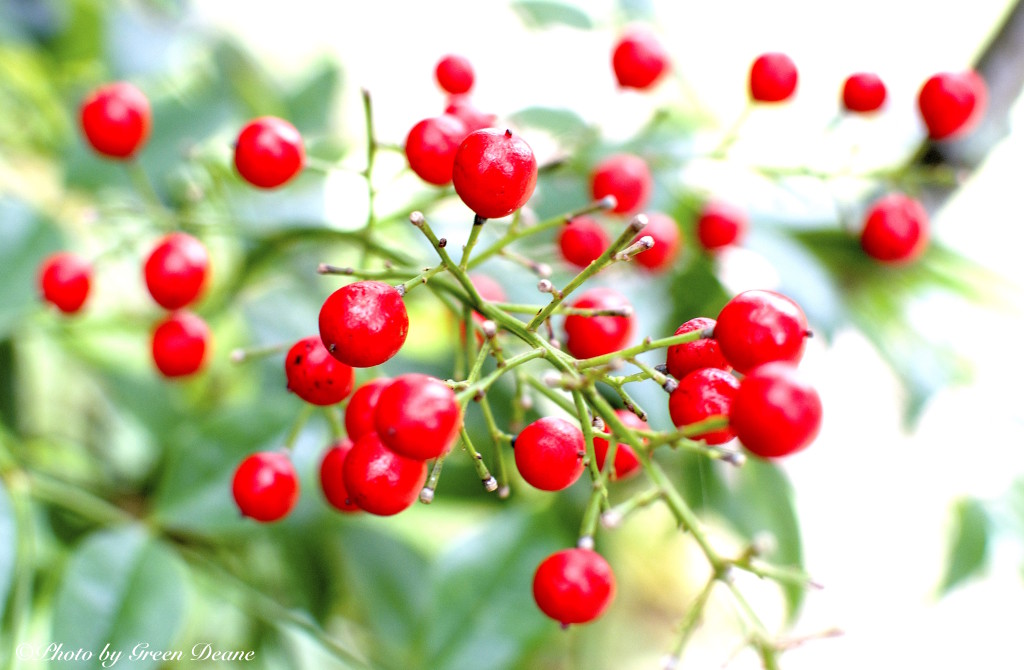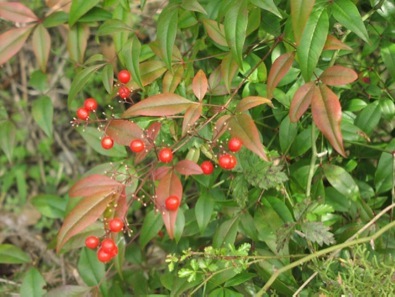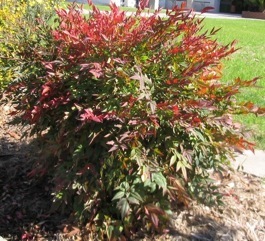Not So Heavenly Bamboo: Nandina
It’s not heavenly nor is it a bamboo, but Heavenly Bamboo is an edible, barely.
Naturalized in many part of the world including the southern United States, it is also a very common landscape ornamental known for its showy color-changing foliage. Young leaves are edible after boiling in two changes of water like poke weed. Whether the berries are edible is in dispute, some say yes, some say no. However, most agree that all they will give you is a mildly upset tummy. In fact that is probably a clue to the berry’s edibility.
A native of Japan, central Asia, and India, the Nandina domestica is a shrub that grows in a clump. It has very distinctive compound leaves that are lance-shaped on multiple non-branching stems. It gives the plant a very lacy appearance. In the fall or spring depending on where you live there are large panicles of small flowers that turn into green berries which ripen to red. There are many cultivars which brings up the issue, what do we call it? Heavenly Bamboo? Sacred Bamboo? Nandina? Or the Japanese name, Nanten? Since it is the only species in its genus I will index it under Nandina.
Regardless of what you call it it was introduced into Japan from China before 1600 and was in the United States by 1804. It prefers rich soil and will not do well in sand. Other than that preference it is a very tough and adaptable plant. It has few pests or diseases, likes sun or shade, and can live to be over a century old. While associated with milder climates it will grow back seasonally from roots in cooler climes. Nandina can be found as far north as Ohio, Maryland, California, up the west coast and in Europe from England south.
The Nandina domestica also attracts wildlife, such as bees to the flowers and several species to its fruit including mocking birds, cedar waxwings and robins. There is one case of cedar waxwings dying after eating only Nandiana berries in 2009. They were all in one yard and to date that is the only report. Cause of death was cyanide in the seeds and the birds had eaten a toxic dose because other food was in short supply. (See study below.) Nandina is also listed as a Class I invasive species in Florida and Texas. There is, however, some debate over that. Some say the plant was declared “invasive” by the very groups that profit by its removal (from state funding) so whether it is invasive or not may be a matter of opinion.
Now let us return to edibility. The leaves are easy to figure out, young and tender boiled twice. Not great but edible. But what of the fruit? Why do some authorities say they are edible and some say they are not, though it is agreed the most they give you if eaten raw in small amounts is a stomach ache. This is pure speculation on my part but since the plant does have hydrocyanic acid in it the Nandina might be like the red elderberry. With that plant the seeds in the berries have hydrocyanic acid and can upset your stomach or make you more sick if consumed in large amounts. However, if you remove the seeds from the red elderberries the pulp is edible. And indeed, Paghat of Paghat.com in Washington says he has removed the seeds from the Nandina berries and made jelly out of them et cetera.
“They can then be used pretty much as other not-so-tasty berries,” Paghat wrote to me, “like mountain ash or hawberries, mixed with sweeter berries or apples improves them lots for jelly; or mixed with cooked pumpkin in a pie recipe.”
Edible pulp and non-edible seeds can create conflicting reports of berry edibility and berry toxicity. All in all, the Nandina is not prime wild eats, but it is very common and persists throughout most of the season. That makes it an edible to know, if prepared correctly. Incidentally, its aromatic wood is considered by the Japanese as excellent for toothpicks. The Japanese also plant it outside home entrances to comfort those who have bad dreams… apparently seeing the pretty shrub scrubs away your nightmare. There is also one odd thing about an alkaloid the plant has, called nantenine. Curiously, that alkaloid blocks the effects of the street drug called Ecstasy. It does make one wonder how they figured that out.
Nandina is an anglicized version of the Japanese name, nanten. Domestica means for or of the house. It is pronounced Nan-DEE-nuh do-MESS-tee-ka.
Green Deane’s “Itemized” Plant Profile
IDENTIFICATION: An evergreen erect shrub to 10 feet high and five feet wide, multiple bushy cane-like stems that resemble bamboo, leaves alternate, bipinnately compound dividing into many 1 to 2-inch, pointed, oval leaflets. Young foliage often pinkish, and soft light green, can be tinged red in winter. Terminal clusters of tiny white-to-pink flowers in early summer, round berries, 1/3 inch in diameter, two-seeded.
TIME OF YEAR: Young leaves any time, berries in fall and winter.
ENVIRONMENT: Highly adaptable disliking only sandy soil.
METHOD OF PREPARATION: Young leaves boiled in two changes of water, berries without the seeds can be made into jelly but is better added to other fruits concoctions.
Toxicity Due to Nandina domestica in Cedar Waxwings (Bombycilla cedrorum)
Many cedar waxwings were found dead in a yard in Thomas County, Georgia, in April, 2009. Five of these submitted to the Tifton Veterinary Diagnostic and Investigational Laboratory, where they were examined grossly and microscopically.
On gross examination, the gastro-intestinal tract of these birds were distended by intact and partly digested berries of Nandina domestica Thunb. (Heavenly Bamboo). These berries were the only ingesta present within the digestive tract of these birds. In all the examined birds, there were gross pulmonary, mediastinal, and tracheal hemorrhages. Microscopically, several tissues and organs including the lungs, liver, kidney, proventriculus, ventriculus, uvea of the eye, heart, the meninges and the brain were diffusely congested and hemorrhagic. The congestion, hemorrhage and edema were very marked in the lungs.
The gross and microscopic findings are consistent with lesions associated with cyanide toxicity. N. domestica berries may contain large quantities of cyanogenic compounds. For most cultivars of N. domestica, cyanogenesis is the most important intoxication factor. As seen in these cedar waxwings, in birds that die from cyanide chemical toxicosis multiple tissues or organs, particularly the lungs, may be hemorrhagic and edematous, and congested with blood. Cyanide is a mitochondrial toxin that impairs cellular respiration, causing morbidity or mortality within a very short time.
During winter and spring, when the food supplies are low or out of season, cedar waxwings migrate in huge numbers from their breeding grounds in the northern U.S. and southern Canada into the more southerly regions, where they feed almost exclusively on fruits. They often eat voraciously, until they can hold no more, and may become intoxicated from eating large quantities of over-ripe fruit.
N. domestica produce vast quantities of bright red berries, which last through the winter into the spring in this region, attracting hungry birds whose food is in short supply during this time of the year. Toxicity associated with N. domestica has not been previously reported in the cedar waxwings. However, due to their voracious feeding behavior, these birds had eaten toxic doses of the readily available berries of N. domestica.





This plant is also a berberine and according to the book “Herbal Antibiotics Natural Alternatives for Treating Drug-Resistant Bacteria” (by Stephen Buhner) the lower branches and roots of this plant are high in berberine (a natural antibiotic). Other more popular medicinal berberines are Goldenseal (Hydrastic canadensis) , Oregon grape (Mahonia aquifolium), and Barberry (Berberis vulgaris). http://books.google.com/books?id=f2hDKZqYNO8C&q=nandina+domestica#v=snippet&q=nandina%20domestica&f=false
Please note this article from the Beaverton Leader newspaper in Beaverton, Oregon talking about how this plant is extremely toxic to birds as well as highly invasive:
http://www.oregonlive.com/beaverton/index.ssf/2014/01/nandina_or_heavenly_bamboo_com.html
I just tried one but I spit out the seed-interesting and quite good though not delicious more like a vegetable flavour but worth a try at least once.
So….Sounds like the jury is still out? I can see why some say it is poisonous, as it contains hydrogen cyanide, however, so do apple seeds, which I eat, and so do almonds. According to Plants For a Future: “In small quantities, hydrogen cyanide has been shown to stimulate respiration and improve digestion, it is also claimed to be of benefit in the treatment of cancer. In excess, however, it can cause respiratory failure and even death.” However, the decoction of leaves is called “tonic” and so are the berries. Hmmmmm.
The other day foragingtexas.com added nandina and since on of my books says this plant has cyanogenic compounds, naturally i wanted to check what my favorite forager Green Deane had to say about it. He never ceases to amaze me at how much information he can conjure about one plant. Like where do you get all the sources? Anyway im not afraid of a little possible cyanide poisoning, so I decided to clear the disinformation. I ate over 20 RAW nandina berries WITH THE SEEDS REMOVED, and had absolutely no side effects. To me they tasted very plain and were dry and mealy, but not at all bad. Personally I wouldn’t hesitate to eat 200 if I was hungry. Point is, myth busted, nandinas are completely safe when raw if you remove the seeds. And anyone who isn’t convinced, comment and I’ll eat even more. I like them. But the leaves on the other hand, anything that you have to boil more than once (including pokeweed), to me just doesn’t seem worth it.
I have seen a few videos where poke berries are consumed, spitting out the seeds, as a treatment for arthritis and other pain.
TJ an rocky pet,s eat every day sure seem to be more alert and TJ lifts both ears the other day they wait looking as top point for me to share them to eat rocky never cared for veggies
Oh, please. Edit your comment and make it intelligible, at least.
Perhaps, we should consider there are those among us who might have visual impairments and instead of offering grammar, punctuation, and linguistic criticism, we read for meaning and in the process-extend some grace.
One of my goals before my book is published next year is to go through the site and correct such minor errors (which I now view as copyright traps.)
Nandina berries are highly toxic to birds. They contain cyanide and other alkaloids that are strong enough to kill birds, including cedar waxwings in a few minutes or within an hour. Here is an article for more information: http://www.oregonlive.com/hillsboro/index.ssf/2013/12/heavenly_bamboo_the_red_berrie.html
But the take-home message is that dozens of cedar waxwings were found dead in Georgia three years ago, investigators at the University of Georgia found the cause to be Nandina berries. Bird autopsies revealed the berries lodged in the birds’ crops, as well as hemorrhaging of several internal organs.
The root of the birds’ distress is the cyanide and other alkaloids contained in the berries that produce highly toxic hydrogen cyanide, which is extremely poisonous to all animals. Sudden death may be the only sign of cyanide poisoning and death usually comes within minutes to an hour of exposure.
Birds don’t boil berries, and what affects one species does not have to affect another. Humans can eat avocados and most other creatures can’t.
Why would you want to encourage people to cultivate an invasive species which kills native birds? You note that nandina attracts cedar waxwings but fail to mention that nandina kills cedar waxwings.
There are several things to point out. First I am not advocating cultivating the plant. Next the article was written many years before the first reported incidence. In both cases (2009 & 2016) it was Cedar Waxwings who had overeaten the berries, which is their nature to do as they are described as gluttons. And it was in the Georgia where the plant fruits longer than northern states. Waxwings prefer native food thus it a case of hungry waxwings in the wrong place at the wrong time eating the wrong plant. It does reenforced the ban on not eating the seeds. They contain cyanide. Also not all Nandias produce berries. I note these bird-appreciating folks also recommend killing the Nandina with Round Up, not exactly environmentally friendly. One can just cut off the blossom or the berries.
👍👍👍for condemning Round Up. Public (councils, maintenance services) and private (homeowners, schools) use it indiscriminately and blithely, ugh!
This plant is known to be dangerous to animals and wildlife, so whether it is dangerous to humans is beside the point. If you value the natural diversity of birds in your area, why on earth would you choose an invasive plant that kills them?!
Answered above. I did not choose Nandia nor did I recommend cultivating it. I am describing it as marginally edible for humans when prepared correctly. I have not seen any reports of the species bothering animals. There are two reported incidents with over eating Cedar Waxwings in Georgia, 2009 and 2016.
“Some say the plant was declared “invasive” by the very groups that profit by its removal (from state funding) so whether it is invasive or not may be a matter of opinion.” Yeah, right, the state and contractors trying to make windfall profits removing heavenly bamboo… Sheesh. UH, possibly it was declared invasive because it KILLS wildlife and therefore must be kept from spreading.
Invasive? I’ve had one in my back yard for over 40 years and it has not spread. Maybe 1.5 foot cluster at the bottom. Never think about it and trim about every 10 years.
Ditto and I live in NC. The invasiveness is way overstated. Nor have I noticed any birds eating it. The wildlife avoid it and therefore I won’t eat it either. It’s really pretty though. I’m thinking of planting hostas and elephant ears for a natural forage, since the cabbage type foliage plants don’t like my soil. Perhaps with elderberries so I can make old timey pink lemonade. Thanks for the explanation of Nandina. For a plant that draws so much ire, I am very fond of the two or three bushes near my home and they look festive and cheerful in the winter with some snow on them. They’re very well behaved for an “invasive” plant. Not really planning on dining on them though.
I’m in north Florida and am finding nandina seedlings coming up in flood plains of a swamp where seed must have been dropped by wildlife. The seedlings are easy to remove, but many plants are mature and fruiting themselves. This plant deserves its places on the list of invasive plants in Florida. Please cut the flowers off your plants.
they say the nandina seeds are poisonious but the truth is it’s poisonious to cancer cells but not to human cells because the enzyme ribonase converts the hydrogen cyanide into useful healthy substances our body can use while cancer cells does have the enzyme ribonase so the hydrogen cyanide is poisonious to cancer cells,something they don’t want us to know about
healthy human cells have rhodanese enzyme that convert hydrogen cyanide into healthy substances for the body while cancer cells lack rhodanese enzymes so the hydrogen cyanide is poisonious to cancer cells,another one of scare tactics they use .i’ve been eating nandina berries with the seeds for about 4 months now and i never even got a upset stomach from eating them.
Thanks, Green Dean, for showing this plant in its true light. I grow it because I love the flowers and I think the bugs love them too.
I also enjoy the fragrance of its wood.
But I am so happy to know that it is not SO highly toxic as it is reputed to be, though I don’t think I will be ingesting any part of it.
Very sorry to hear about the waxwings. I had read that report too, which was what had made me think that the plant was harmful.